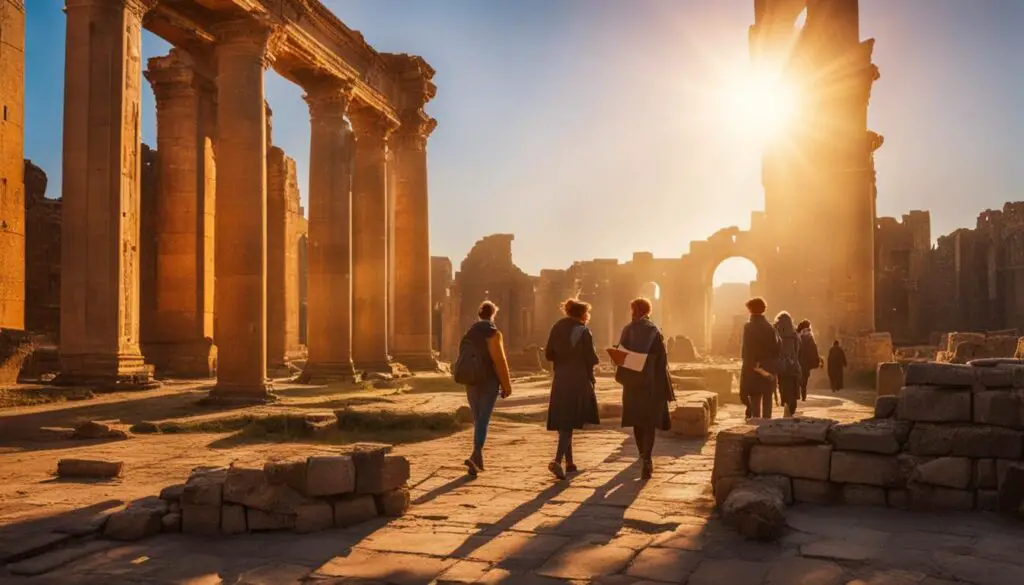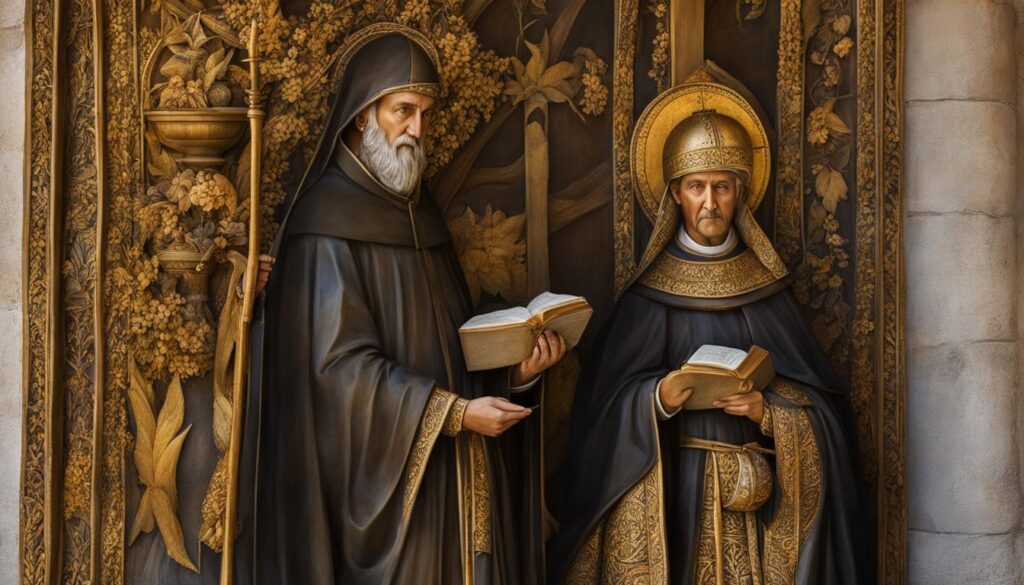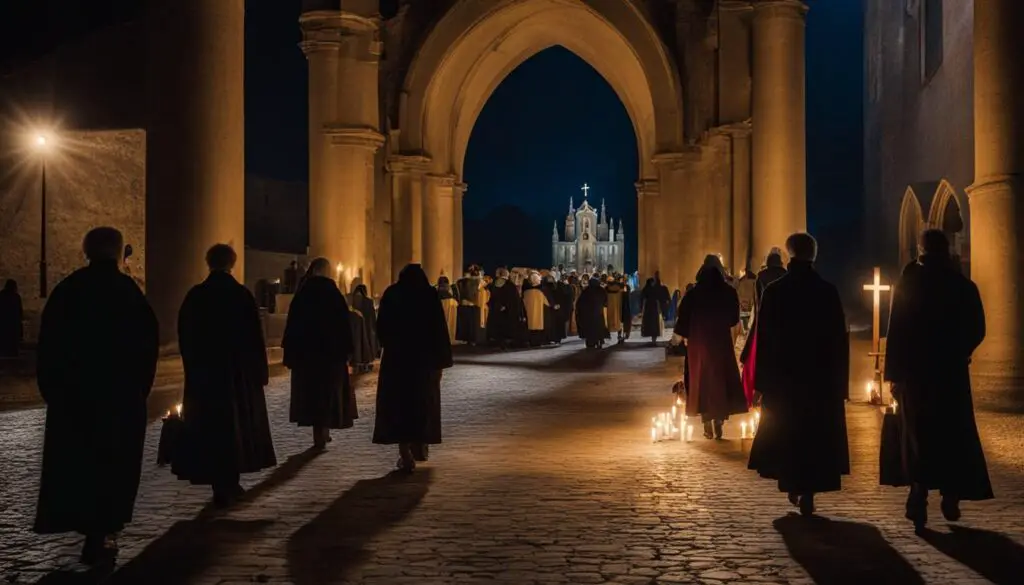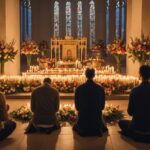Are you looking for a meaningful way to celebrate Holy Thursday? The tradition of the Seven Churches Visitation might be just what you’re looking for. This spiritual journey involves attending Mass on Holy Thursday and then visiting seven different churches, praying before the Blessed Sacrament at each one. It is a beautiful and profound way to deepen your faith and connect with the ancient roots of Catholicism.
Key Takeaways:
- Participating in the Seven Churches Visitation is a unique way to celebrate Holy Thursday.
- The tradition involves visiting seven different churches and praying before the Blessed Sacrament at each one.
- It is important to plan ahead and choose churches that are in close proximity to each other.
- Reflecting on the symbolism of the seven churches in Revelation can deepen your understanding of the challenges Christians face.
- The tradition has its roots in the ancient practice of praying the Stations of the Cross.
The Origins of the Seven Churches Visitation Tradition
The tradition of the Seven Churches Visitation has a rich history dating back to the origins of the Christian faith. This holy tradition can be traced back to the practice of praying the Stations of the Cross, where believers would visit various locations associated with Christ’s Passion. Over time, this custom evolved into the Seven Churches Visitation, which calls for visiting seven churches on Holy Thursday.
The tradition originated in Rome, where it was believed that visiting seven churches allowed believers to retrace the steps of Christ before His Crucifixion. Two stations of the Cross were prayed at each church, creating a profound spiritual journey for participants. As this practice spread to other parts of Europe and Latin America, it became a significant aspect of Holy Thursday celebrations around the world.
The Seven Churches Visitation tradition continues to be observed by many Catholics today, providing a unique opportunity to connect with the ancient roots of the faith and honor the events of Holy Thursday. By participating in this tradition, believers can deepen their understanding of Christ’s sacrifice and find renewed inspiration in their spiritual journey.
| Country | Year of Introduction |
|---|---|
| Rome, Italy | Unknown, but traced back to ancient times |
| Spain | Unknown, but popularized during the Middle Ages |
| Mexico | 16th century, introduced by Spanish colonizers |
| Philippines | Unknown, but integrated into Filipino culture |
| Puerto Rico | 19th century, brought by Spanish influence |
| United States | Unknown, but practiced in areas with multiple Catholic churches |
How to Participate in the Seven Churches Visitation
If you’re interested in participating in the Seven Churches Visitation tradition, here are some steps to guide you through the process:
- Choose a starting church for Holy Thursday Mass: Select a church where you can attend Mass on Holy Thursday to begin your spiritual journey. This will set the tone for the rest of the day.
- Create a route: Map out a route to visit the other six churches. Consider factors such as proximity, opening times, and the ability to carpool with friends or family to make the experience more enjoyable.
- Plan your visit: Take into account the time it takes to travel between churches, as well as the time you’ll spend at each location. You may want to allocate more time at certain churches that hold particular significance for you.
- Invite others to join: The Seven Churches Visitation can be a powerful experience to share with others. Send out invitations to friends, family, or fellow parishioners to join you on this spiritual journey.
- Prepare spiritually: Before embarking on the visitation, take some time to reflect on the significance of Holy Thursday and the stations of the cross. Consider the intentions you want to pray for and the graces you hope to receive.
The Seven Churches Visitation is a unique and meaningful way to spend Holy Thursday, deepening your faith and reflecting on the journey of Christ. By following these steps, you can ensure a smooth and fulfilling experience as you participate in this spiritual tradition.

The Seven Churches Visitation Route
| Church | Location | Opening Times |
|---|---|---|
| Church of St. Peter | 123 Main Street | 6:00 AM – 8:00 PM |
| Church of the Holy Cross | 456 Elm Avenue | 7:30 AM – 9:00 PM |
| Church of St. Mary | 789 Oak Drive | 8:00 AM – 10:00 PM |
| Church of the Immaculate Conception | 101 Pine Street | 9:00 AM – 11:00 PM |
| Church of St. Joseph | 234 Maple Avenue | 10:00 AM – 12:00 AM |
| Church of the Assumption | 567 Birch Lane | 11:00 AM – 1:00 AM |
| Church of the Sacred Heart | 890 Walnut Street | 12:00 PM – 2:00 AM |
The Symbolism of the Seven Churches in Revelation
In the book of Revelation, Jesus addressed letters to seven churches in Asia Minor. These churches were Ephesus, Smyrna, Pergamos, Thyatira, Sardis, Philadelphia, and Laodicea. Each church had its own strengths and weaknesses, and Jesus offered words of encouragement and correction to each one. These letters serve as a reminder of the challenges Christians face and provide guidance on overcoming trials. The messages of the seven churches in Revelation are still relevant today.
The symbolism of the seven churches goes beyond their historical context. Each church represents a different aspect of the Christian faith and the struggles that believers may encounter. The messages to the churches highlight the importance of faithfulness, perseverance, repentance, and spiritual growth.
“To him who overcomes…” is a recurring statement in the letters to the seven churches. It emphasizes the need for Christians to remain steadfast in their faith and overcome the obstacles they face. These letters remind us that although we may face trials and tribulations, we can find strength and victory through Christ.
The Seven Churches and their Symbolic Meanings:
- Ephesus: The church of Ephesus represents the loss of their first love and the need to return to their initial zeal for Christ.
- Smyrna: The church of Smyrna represents persecution and tribulation, encouraging believers to remain faithful even in the face of hardship.
- Pergamos: The church of Pergamos represents compromise and the danger of allowing false teachings and practices to infiltrate the church.
- Thyatira: The church of Thyatira represents the dangers of immorality and idolatry, emphasizing the importance of maintaining purity and fidelity to Christ.
- Sardis: The church of Sardis represents spiritual deadness and the need for revival and genuine repentance.
- Philadelphia: The church of Philadelphia represents faithfulness and perseverance, promising rewards to those who remain steadfast in their devotion to Christ.
- Laodicea: The church of Laodicea represents lukewarmness and self-sufficiency, urging believers to be zealous for the Lord and not complacent in their spiritual lives.
The messages to the seven churches in Revelation remind us of the importance of embracing and embodying the characteristics that Christ commends. They serve as a guide for self-reflection, allowing us to evaluate our own spiritual lives and make necessary adjustments to align ourselves with God’s will. By learning from the strengths and weaknesses of these churches, we can grow in our faith and strive to overcome the challenges we face as Christians.
| Church | Main Message | Symbolic Meaning |
|---|---|---|
| Ephesus | Return to your first love for Christ | Loss of initial zeal |
| Smyrna | Remain faithful in the face of persecution | Persecution and tribulation |
| Pergamos | Guard against compromise and false teachings | Compromise and danger of false practices |
| Thyatira | Maintain purity and fidelity to Christ | Immorality and idolatry |
| Sardis | Repent and revive your spiritual life | Spiritual deadness |
| Philadelphia | Remain faithful and persevere | Faithfulness and perseverance |
| Laodicea | Be zealous for the Lord, not lukewarm | Lukewarmness and self-sufficiency |
The Legacy of St. Philip Neri and the Seven Churches Pilgrimage

St. Philip Neri, also known as the ‘Second Apostle of Rome,’ was a missionary and healer who lived in the 16th century. His legacy lives on through the tradition of the Seven Churches pilgrimage, a walking journey through the streets of Rome that involves visiting the seven basilicas of the city. This pilgrimage was a way for St. Philip to bring renewal and revival to the Church and the people of Rome, allowing them to deepen their faith and encounter the love of God.
The Seven Churches pilgrimage became a popular tradition among both locals and visitors to Rome. Participants would embark on a spiritual journey, following in the footsteps of St. Philip as they visited the seven basilicas: St. Peter’s Basilica, St. Paul Outside the Walls, St. John Lateran, Santa Maria Maggiore, St. Lawrence Outside the Walls, Holy Cross in Jerusalem, and San Sebastiano fuori le mura. Each basilica holds its own historical and religious significance, offering pilgrims a unique experience at every stop.
By participating in the Seven Churches pilgrimage, individuals have the opportunity to connect with the rich spiritual heritage of Rome and draw inspiration from St. Philip Neri’s devotion and love for souls. This meaningful journey allows pilgrims to reflect on their own faith, offer prayers for their intentions, and seek God’s guidance and grace. The Seven Churches pilgrimage continues to be a cherished tradition that invites believers to deepen their relationship with God and experience the profound history and spirituality of Rome.
Keeping Christ Company on Holy Thursday
On Holy Thursday, there is an invitation to keep Christ company by making a pilgrimage to seven different churches. This tradition calls for reflecting on the final seven places Christ visited before His Passion and Death. It is an opportunity to walk in the footsteps of Christ and meditate on His sacrifice. By spiritually accompanying Christ during His agony in the garden and His journey to Calvary, we can deepen our understanding of His love and find renewed zeal for the faith.
As we visit each church, we can take a moment to pause, pray, and reflect on Christ’s Passion. It is a time to contemplate His unwavering love and the immense suffering He endured for our sake. By immersing ourselves in this holy journey, we can experience a profound connection with Christ and gain a deeper appreciation for the profound impact of His sacrifice.
Keeping Christ company on Holy Thursday is a powerful way to honor His Passion and express our gratitude for His immense love. By actively participating in this pilgrimage, we open our hearts to receive the transforming grace that flows from Christ’s sacrifice. Through prayer, reflection, and contemplation, we can renew our commitment to follow Christ and strive to live out His teachings in our daily lives. This spiritual journey on Holy Thursday is an opportunity to draw closer to Christ, to grow in holiness, and to deepen our relationship with our Savior.

Key Points:
- On Holy Thursday, we are invited to make a pilgrimage to seven churches to keep Christ company.
- This tradition allows us to reflect on Christ’s final places before His Passion and Death.
- By spiritually accompanying Christ during His agony and journey to Calvary, we deepen our understanding of His love.
- Visiting each church offers a time for prayer, reflection, and contemplation of Christ’s sacrifice.
- Keeping Christ company on Holy Thursday is an opportunity to honor His Passion and deepen our faith.
Reflecting on the Seven Stations of Christ’s Passion
The Seven Churches pilgrimage involves reflecting on seven stations of Christ’s Passion. These stations represent significant moments in the events leading up to Christ’s crucifixion and death. By pausing at each church along the pilgrimage, participants have the opportunity to meditate on the profound sacrifice of Jesus and gain a deeper understanding of His love and mercy.
At the first station, Jesus is in the Garden of Gethsemane, where He experiences intense anguish and prays to the Father before His arrest. The second station marks His appearance before Annas, the high priest, and the third is His trial before Caiaphas, the high priest’s father-in-law. This journey continues as Jesus stands before Pilate, Herod, and Pilate again, each encounter further illustrating the injustice and suffering He endured.
The final station brings us to Calvary, where Jesus is crucified and dies for the sins of humanity. Reflecting on these stations allows us to enter into the depth of Christ’s passion and sacrifice, inspiring us to embrace His teachings and follow His example of selfless love. It serves as a powerful reminder of the price He paid for our redemption and encourages us to live lives of faith, hope, and love.
| Station | Description |
|---|---|
| 1 | Jesus in the Garden of Gethsemane |
| 2 | Jesus before Annas |
| 3 | Jesus before Caiaphas |
| 4 | Jesus before Pilate |
| 5 | Jesus before Herod |
| 6 | Jesus before Pilate again |
| 7 | Jesus’s crucifixion and death |
Conclusion
The Seven Churches Visitation and the tradition of making a pilgrimage to seven churches on Holy Thursday offer a unique and meaningful way to deepen one’s faith. This spiritual journey allows participants to reflect on Christ’s sacrifice and invoke prayers for church growth, unity, and healing.
By visiting each church and spending time in prayer, individuals can seek God’s guidance and grace for the growth of their local church and the broader Church community. It is an opportunity to come together in prayer and support the mission and ministry of the Church.
Through this tradition, believers can express their devotion to the Church and its role in spreading the message of Christ. The prayers for church growth, unity, and healing serve as a reminder of the importance of collective faith and the need to come together in times of challenge and celebration.
FAQ
What is the Seven Churches Visitation tradition?
The Seven Churches Visitation tradition involves attending Mass on Holy Thursday and then visiting seven different churches, praying before the Blessed Sacrament at each one.
Where did the Seven Churches Visitation tradition originate?
The tradition originated in Rome and has since spread to other countries, including the United States.
How can I participate in the Seven Churches Visitation?
To participate, choose a starting church for Holy Thursday Mass and then map out a route to visit the other six churches. Consider factors such as proximity, opening times, and the ability to carpool with friends or family.
What is the significance of the seven churches mentioned in the Book of Revelation?
The seven churches mentioned in the Book of Revelation represent different strengths and weaknesses of the early Christian communities. Jesus offered words of encouragement and correction to each one.
Who was St. Philip Neri and how is he connected to the Seven Churches Pilgrimage?
St. Philip Neri, also known as the ‘Second Apostle of Rome,’ led a walking pilgrimage through the streets of Rome, visiting the seven basilicas of the city. This tradition was a way to bring renewal and revival to the Church and the people of Rome.
Why is it important to keep Christ company on Holy Thursday?
Keeping Christ company on Holy Thursday through prayer and reflection allows us to meditate on His sacrifice and deepen our understanding of His love.
What are the Seven Stations of Christ’s Passion?
The Seven Stations of Christ’s Passion include Jesus in the Garden of Gethsemane, Jesus before Annas, Jesus before Caiaphas, Jesus before Pilate, Jesus before Herod, Jesus before Pilate again, and Jesus’s crucifixion and death.








